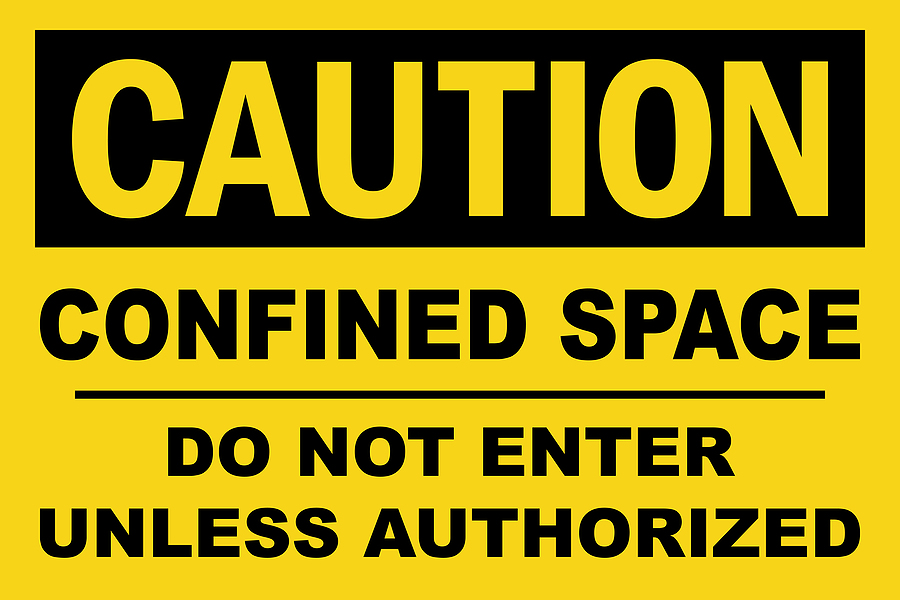The Nuts and Bolts of Confined Space Training Requirements

The training for working in tight/confined spaces requires some special standards and protocols in order to ensure worker’s safety in the construction industry. Working in restricted places / confined spaces is a dangerous yet unavoidable factor of a construction industry job. A confined space can be of any shape or size.
As per OSHA, any workplace that fulfills the below 3 requirements falls under the category of confined space:
- Not necessarily designed for people to work, but are large enough that employees can enter and perform certain job roles.
- Has limited entry or exit points
- Aren’t intended for continuous occupancy
Examples of confined spaces may include but aren’t limited to, tanks, tunnels, vessels, furnaces or boilers, silos, pits, pipelines, equipment housings, mixers, hoppers, manholes, vaults, storage bins, ductwork, etc.
Every worker in the construction sector should approach any unfamiliar location/area as a potential confined space. These cautionary measures will help ensure a safe working environment for everyone.
You Must Know: “Any place with known hazardous conditions (where dangers are detected in advance ) is termed as permitted space”.
It’s an undeniable fact that working in confined spaces exposes employees to a range of dangers, including physical and atmospheric hazards, as well as risks of toxic chemicals, explosions, electrocutions, and asphyxiation. However, proper planning and training can reduce the risk of hazards in confined spaces.
What Does OSHA Confined Space Training Involve?
The OSHA Confined Space Standard, originally established in 1993, was designed to safeguard employees in the general industry. Recognizing the fact that construction sites have unique and dynamic confined space challenges and their own areas prone to frequent changes, OSHA introduced a specialized training standard for the construction sector in 2015.
OSHA (Occupational Safety and Health Administration) has made it mandatory that employees must have special training specialists in health and safety or industrial hygienists before entering in confined spaces. As per the training rules:
- All the attendees and participants of the training must showcase their knowledge, understanding, and expertise.
- Before entering a confined space, every team member must participate in the special training.
- Whoever authorizes entry into the restricted area must be fully aware of its contents, including any potential hazards.
It’s the responsibility of the access authorizing person to ensure that every employee understands the potential challenges they will face and their specific duties. As per the OSHA guidelines, training is essential not only for the workers entering the confined area but also for attendants, supervisors, and the rescue team.
Furthermore, the training must be provided to employees for free, it must be documented and offered at a vocabulary and language level that every employee can easily understand.
Entrant / Workers Training
Employers must ensure that employees entering the confined space are trained enough to identify potential dangers. For that purpose,
- They must communicate with each other outside the designated restricted zone.
- Workers should be able to recognize warning signs of danger and inform the attendants accordingly.
- Employees must be aware of how to properly employ personal protective equipment (PPE) and tools, knowing where to find them and how to utilize them effectively.
- Last but not least, employees must have knowledge of self-rescue techniques.
Attendant Training
Attendants positioned outside the confined space need to be trained in their specific roles. Similarly, every worker entering the restricted area is also required to receive training on attendant responsibilities.
It’s the responsibility of participants to :
- Keep an accurate count of all individuals entering the restricted area.
- Identify potential hazards and keep an eye on environmental conditions.
Oversee And Coordinate Rescues
Carry on continuous communication while authorizing entry to the restricted space and when issuing instructions to evacuate if employees encounter conditions that aren’t specified in the entry permit, if their behavior changes, they’re unable to handle danger, any external factor can harm workers, or if the attendant needs to leave to handle an emergency at another site they are monitoring.
Entry Should be Restricted to Only Authorized Employees
Attendants of employees aren’t allowed to enter confined workspaces in any conditions. They can only participate in rescue operations outside the restricted area.
General Training
With the exception of rescue personnel, all other workers receive training on the risks involved in assisting the recovery of a fellow team member.
Individuals entering confined spaces to rescue a team member account for over half of the fatalities linked to such environments. Based on this fact, confined space training is a must for everyone.
Are you interested in learning more about OSHA confined space training? Contact Safety Counselling Inc. at (505) 881-1112. Safety Counselling Inc. is one of the best companies that provide safety training in Albuquerque, NM.
